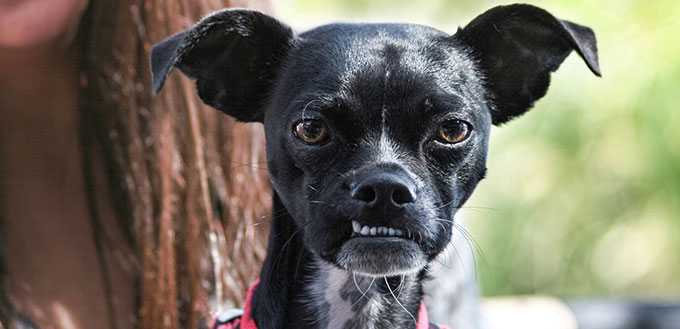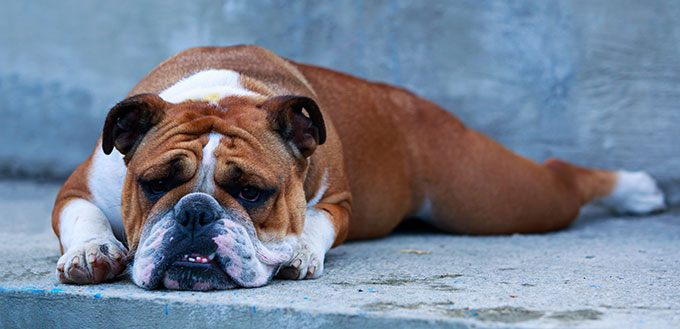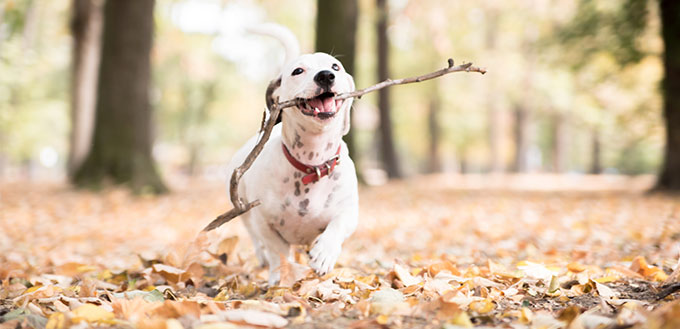Walking down the street, you’re likely to notice plenty of dogs with a slight overbite. In fact, in some breeds, dogs with an overbite are completely natural – so you may well find that overbites in both puppies and adult dogs are more common than you think! Just like so many other features of a dog, such as the patterning of their fur, the shape of their face and the color of their eyes, a dog’s jaw alignment is something which can vary from pup to pup and is unique to them.
However, you may find your dog is showing signs of an overbite, which can be quite uncomfortable for them or, in some cases, painful. In this article, we’ll tell you what to look for in a puppy overbite and whether or not this is likely to be an issue. Furthermore, we’ll discuss the most common dog breeds with an overbite, whether you should be concerned about your puppy overbite and help you if you are worried about your dog overbite.
What Is an Overbite?
An overbite, which can go by many terms such as an overshot jaw, an over-jet, class 2 malocclusion or mandibular brachygnathism, can be characterized by a misalignment in a dog’s jaw. This misalignment causes the teeth of the upper jaw to be displaced in such a way that they sit forward from the teeth of the lower jaw.
It can also occur when your dogs’ lower jaw is considerably shorter than their upper jaw. Whatever the cause, the gap created by the space between the two parts of the jaw can cause multiple problems. Since there is a space between their teeth, the overbite will stop your pup from being able to bite down effectively. This, in turn, causes problems with eating which can worsen as the misalignment changes – effectively causing the issues to increase over time.
What Causes a Dog With Overbite?
An overbite can be a genetic, hereditary condition which is passed down from the parents to the puppy, often found with certain breeds of dog, such as those discussed below. Contrary to what you may think, however, it is also possible for parents with a perfect bite to still produce a puppy with an overbite. While this doesn’t mean that anything is wrong with the parents, it can still cause problems with the puppy and is simply an oddity that your pup has been born with.
Sometimes, you might also notice that an otherwise healthy dog may be showing signs of an overbite. In these cases, it is likely something that has developed over time, through something like excessive chewing which causes the teeth to adjust at an atypical angle and therefore an overbite to be created.
What Are the Symptoms of an Overbite?
There is a variety of symptoms that may be caused by an overbite, some of which can be more extreme than others dependent on the severity of the malocclusion. The things to look out for are:
Periodontal Disease
This is a gum disease which causes an inflammation or infection that can weaken the surrounding support structure of the teeth and cause them to become loose or fall out. Usually, this is caused by food and bacteria accumulating at the base of the teeth and along the gums causing plaque (otherwise known as tartar) to form.
Symptoms of Periodontal Disease Include
- Irritability (caused by discomfort)
- Loss of appetite or difficulty eating
- Excessive drooling
- Bad breath
- Bleeding or red gums
- Loose teeth or, at advanced stages, teeth falling out
Periodontal disease can be prevented with a proper diet, watching what your dog is chewing on, and the use of proper oral hygiene processes, such as brushing your dog’s teeth regularly (if you are unsure, consult your veterinarian on how often they would advise you do this). Remember that periodontal disease can cause irreversible damage, and so by using these processes you can avoid any issues with the teeth in the future.
Oral Irritation
Oral irritation can often be caused by the rubbing of the teeth on the lower jaw against the roof of the mouth due to the misalignment. This irritation can include bruising, grazing, blistering, injury to the inner cheek, soft tissue defects in the mouth or even puncturing of the hard palate.
As you can imagine, oral irritation can be caused by numerous issues and you can easily spot the damage within the mouth by checking the gums regularly. Doing this can often help you find the root cause of the irritation and will help you discuss possible causes with your vet.
Wear and Tear
Due to their misalignment, your dog may struggle with the excessive wearing of their teeth, due to them rubbing and grinding against each other, as they don’t fit together the way that they should. If you notice any extra wear and tear along the teeth, do speak to your vet to see if there is any way you can help, such as a change in diet (to lessen the level of chewing required when eating) or similar ways to resolve the damage.
Difficulty Picking up Food and Eating
Some dogs with an overbite or overbite may have difficulty eating as the protruding jaw may be an obstruction when trying to reach their food. There are several ways in which you can help your dog to feed:
- Angling the food bowl so that their food is gathered in one place
- Handfeeding
- In severe cases having several teeth removed
It would also be advisable to approach your vet for any further suggestions they may have regarding feeding with a severe overbite, as both you and your vet will know your dog best and what works for them.
Which Dog Breeds have Overbites?
An overbite is a condition most commonly found in dogs with narrow, long muzzles, which are also referred to as dolichocephalic dog breeds. Listed below are some of the breeds you may expect to see with an overbite:
- Border Collies
- German Shepherds
- Dobermann Pinschers
- Dachshunds
- Basset Hounds
- Greyhounds
- Whippets
- Afghan Hounds
- Cavalier King Charles
Puppies with an Overbite
Puppies can often begin to show signs of an overbite as young as 8-12 weeks of age, which can help you to look at ways to prevent it from developing. By the time a puppy is 10 months old, all jaw alignment will be permanent and any overbite treatment you may choose to pursue will become more challenging.
Minor overbites can be common in small puppies, although they may self-correct as the puppy grows and matures, just as it can with a human. This being said, it would be advisable to avoid playing any strength games with your pup that could cause the deformation to become exacerbated, such as tug-of-war, as this can put a strain on the jaw.
How to Treat an Overbite
The best way to treat an overbite is by following the advice of your vet. A thorough dental examination can help you catch and stop any problems with the teeth before they become an issue. Remember that an overbite is not something that is necessarily a complete hindrance, but checking with your vet is always advised.
In severe cases, intervention may be recommended by your veterinarian in order to prevent further deformation, while your puppy is young. There are several methods that can be applied to help correct an overbite before it becomes too much of a problem. It is, however, important to remember that whilst an overbite may look unsightly, it does not always affect the dog in a negative way, in which case forcing them to undergo invasive preventative or corrective procedures may be of more stress to the dog than benefit.
Tooth Extraction
For some dogs with an overbite, the simplest method is to use tooth extraction to remove the teeth that are beginning to interlock. This would allow the jaw to loosen and provide space for the puppy overbite to straighten before their adult teeth come through.
Orthodontic Accessories
There are several accessories that can be used to intervene with the misalignment such as spacers and braces. The amount of time necessary for these methods will vary depending on the dog’s age. If the puppy is young enough, they may only be needed for a few weeks. However, if the dog is slightly older then they may be required for up to two years.
Treatments for Periodontal Disease
There are several stages to periodontal disease, therefore resulting in several treatment options dependent on the severity. For stages 1 and 2 this is a simple matter of their teeth being thoroughly cleaned to avoid any further decay, the removal of plaque and often the use of a decide called a ultrasonic scaler which can remove the calculus (a particularly hard plaque that can pull the gums away from the teeth, causing pockets to form which would invite further infection). Often, this can stop the issue before it develops further – at which point an extraction is usually preferred.
The last treatment, used for the most severe cases would be periodontal surgery, which would entail opening the gums to clean, treat with antibiotics and seal the affected roots, followed by providing them with a bone growth stimulant. The removal of dying and damaged teeth may also be necessary during this process, and would be followed by pain medication to aid with healing and a soft food diet for three to four weeks whilst the mouth is given time to heal.
Sources:
- Maura McAndrew, Dogs with Underbites: What Is Canine Malocclusion?, PetMD
- Adrienne Farricelli, Overbites in Puppies, The Nest
Leave a reply
Note: The advice provided in this post is intended for informational purposes and does not constitute medical advice regarding pets. For an accurate diagnosis of your pet's condition, please make an appointment with your vet.











HELLO! I have a 7month old female shorkie and my God she bites but is aggressive. She attacks the furniture.everytoy. I notice she finds comfort when she keeps it in for at least a few seconds like 10 sec…I was watching her back teeth molars I am assuming are very very sharp Could it be possible when she bites that it might hurt her. I am anxious to find a solution for her. ( LUNA)